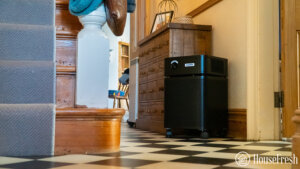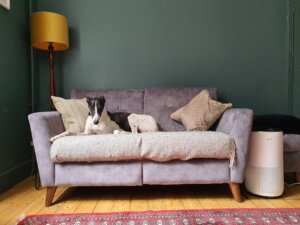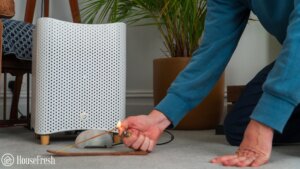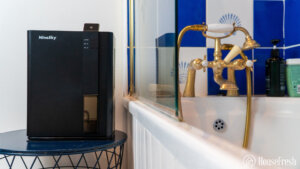Air purifiers used to be nice gadgets for those who could afford them. But COVID-19 changed everything.
Since 2020, there has been an explosion of interest in devices that can clean airborne particles from the air. Reputable organizations such as the Centers for Disease Control and Prevention and the World Health Organization have stated that portable air purifiers can improve indoor ventilation and remove harmful airborne particles.
All this to say that everyone is much more aware now of how the air we breathe can impact our health, which is great news. The problem is that this has led to online marketplaces like Amazon and retailers like Best Buy becoming flooded with cheap units that promise to do it all for a quarter of the price.
After testing over 60 air purifiers in the last two years, I am here to tell you that not all cheap air purifiers are created equal.
There is A LOT of misinformation out there, powered by paid influencers, sponsored ads and fake reviews. On top of that, every big magazine under the sun has decided to monetize its traffic through affiliate commissions, publishing page upon page with air purifier reviews without actual testing.
So, if you are on a tight budget but need an air purifier for your home, make sure to do your research BEFORE you buy, so you don’t end up like this Redditor, who bought two different air purifiers before she realized they didn’t work and had to buy a third one to help with her cat allergies.
- In our home lab of 728 cubic feet, we light an incense stick to generate particle pollution and VOCs.
- We set up our trusted Purpleair Indoor Sensor with the latest Bosch gas sensor to track levels of PM1ug/m3, PM2.5ug/m3 and PM10ug/m3 and VOCs in the air.

- We switch the air purifier to its highest speed and measure how long it takes to get our room air quality down to PM1 level to 0.
- We use an energy meter to measure precisely how much electricity is used when running the unit at the lowest and highest fan speed settings.
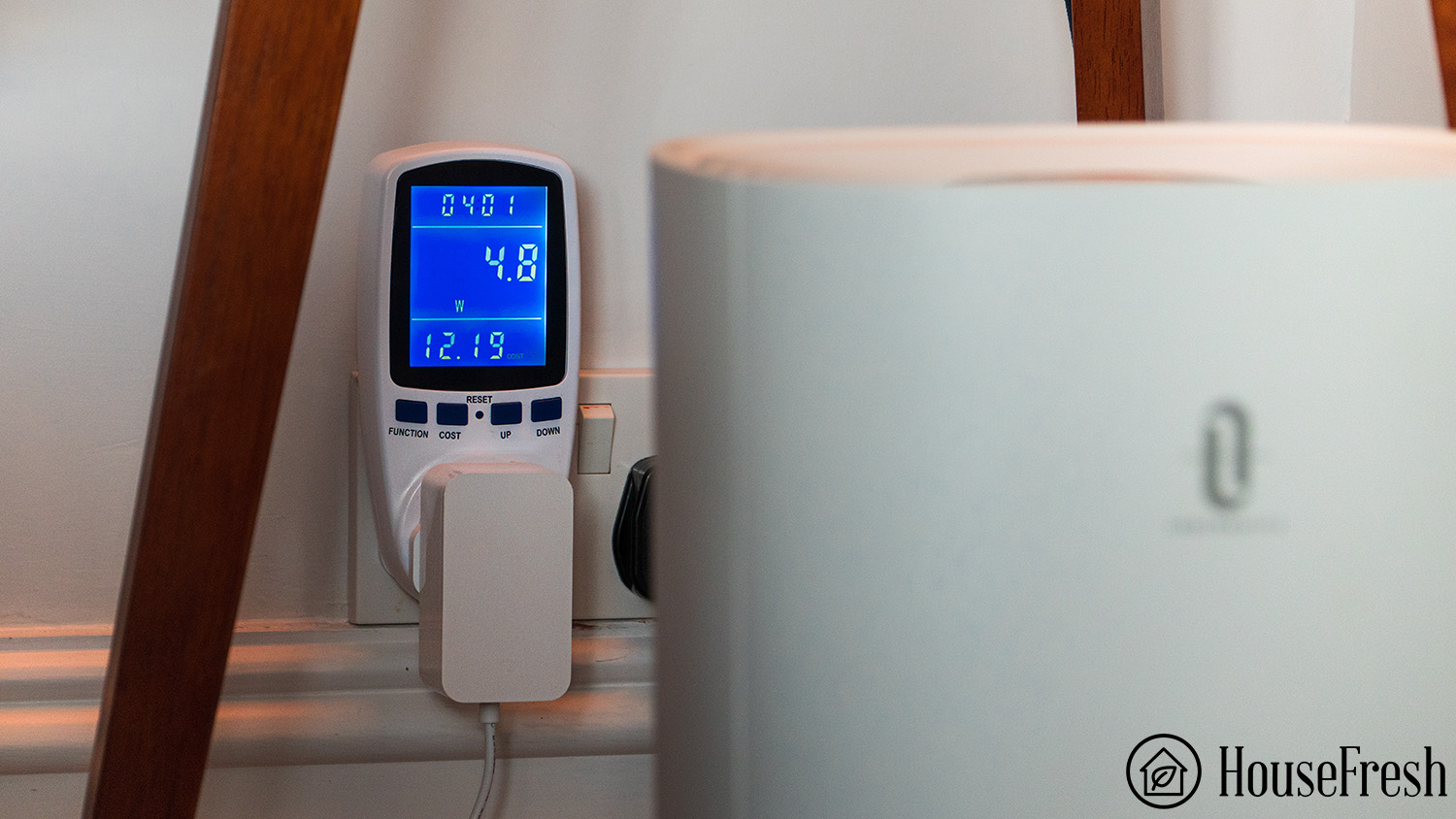
- We track sound levels emitted by the air purifier at different fan speeds with the help of a commercial sound meter.

I used the data we collected from our tests to build a shortlist of solid air purifiers that will not cost you an arm and a leg to buy AND to run in the long term.
That’s right, I didn’t just focus on upfront costs.
When choosing the best budget air purifiers, I did the math to determine how much it could cost to run each unit across 12 months, including energy consumption and filter replacement costs.
When you’re on a budget, the best way to get the best cleaning power is to use multiple units instead of just one. If your unit has a CADR of 150 CFM, two units working together will have a CADR of 300 CFM.
Staff picks: Top 3 budget air purifiers
If you don’t have time to read our full article, you’ll find our top recommendations in the table below.
| 👑 BEST OVERALL | 💰 FOR TIGHT BUDGETS | 🛋️ FOR LARGE SPACES | |
|---|---|---|---|
| Winix A231 (A230) | Levoit Core 300 | TaoTronics AP003 | |
 |  |  | |
| Air cleaning speed | 36 minutes | 40 minutes | 29 minutes |
| CADR rating | 149 CFM | 145 CFM | 226 CFM |
| Filter technology | Pre-filter, True HEPA filter, activated carbon filter + PlasmaWave | Pre-filter, main pleated filter, and activated carbon filter | H13 HEPA with activated carbon pellets |
| Max room size | up to 230 sq. ft. | up to 219 sq. ft. | up to 322 sq. ft. |
| Weight | 7.1 lbs (3.2 kg) | 7.48 lbs (3.4 kg) | 18 lbs (8.16 kg) |
| Our review | Winix A231 (A230) review | Core 300 review | TaoTronics AP003 review |
| Price | $77.16 | $99.99 | $79.99 |
Last update on 2024-04-17 / Affiliate links / Images from Amazon Product Advertising API
Let’s do this then. These air purifiers will give you the best bang for your buck when looking at the ratio of air cleaning power to money spent:
1. Staff pick: Winix A231/A230 ($79.99 upfront + $95.19 per year)
At less than $80, it’s the best budget air purifier we have tested and does an excellent job of cleaning the air.

The Winix A230 is white and grey and the A231 is black, but other than that, they are exactly the same. This little air purifier comes with an onboard air quality sensor, which makes it possible for its auto-mode to kick in autonomously as soon as it detects air pollutants. It also comes with PlasmaWave ionizer technology, which is a signature feature in Winix devices that gives them a performance boos when needed.
What we really like
What we think could be better
It’s still a small unit, so bear in mind that it will not be suitable for rooms bigger than 230 sq. ft., but it’s still quite powerful and completed our air cleaning performance test in 36 minutes — that is three full minutes faster than the Levoit Core 300S and two minutes faster than the Shark HP102.


SPECS & FEATURES
| HouseFresh rating: | ★★★★★ |
| Time to clean our test room: | 36 minutes |
| Air purifier technology: | Fine mesh pre-filter, True HEPA filter, activated carbon filter, PlasmaWave technology |
| Recommended room size: | Up to 230 sq. ft. |
| Clean air delivery rate (CADR): | – Dust: 149 CFM – Pollen: 154 CFM – Smoke: 147 CFM |
| Dimensions (in inches / in cm): | 9.5D x 9.5W x 14.6H inches (24.13D x 24.13W x 37H cm) |
| Weight (in pounds / in kg): | 7.1 lbs (3.2 kg) |
| Noise level (measured from 3 ft. away): | Speed 1: 35.2 dB Speed 2: 48.3 dB Speed 3: 57.9 dB |
| Filter life: | 12 months |
| Electricity consumption (kilowatt-hour): | Standby mode: 0.06 kWh Speed 1: 35.4 kWh Speed 2: 37.7 kWh Speed 3: 45.6 kWh |
| Estimated running costs (electricity consumption + filter replacements): | $95.19 per year |
| Manufacturer’s warranty: | 2 years |
| Country of manufacture: | South Korea |
2. Best for small spaces: Levoit Core 300 ($99 upfront + $107 per year)
One of the best units in terms of air cleaning performance per $ spent, the Core 300 is a great choice for those who don’t care about smart functions.
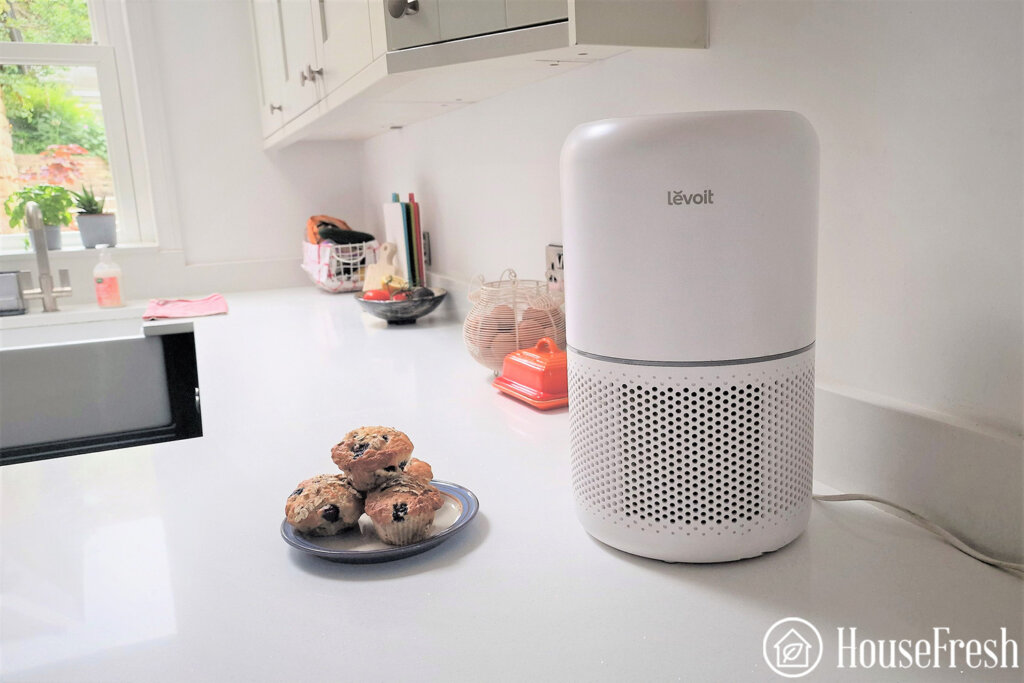
The Levoit Core 300 changed the budget air purifier game forever when it arrived on the scene. Back then, budget air purifiers were useless or had ionizers that could actually make things worse by adding dangerous ozone to your air.
What we really like
What we think could be better
Levoit brought an air purifier capable of 145 CFM for $99.99 to market. Previously, you could get 100 CFM with the Honeywell HP100, but now you can get 1 CFM for 68 cents. Our performance test cleaned our test room in 40 minutes of particles measuring 1 micron or less.
Keeping the air clean no longer needs large, costly devices beyond most American households’ budgets. Levoit, we salute you!
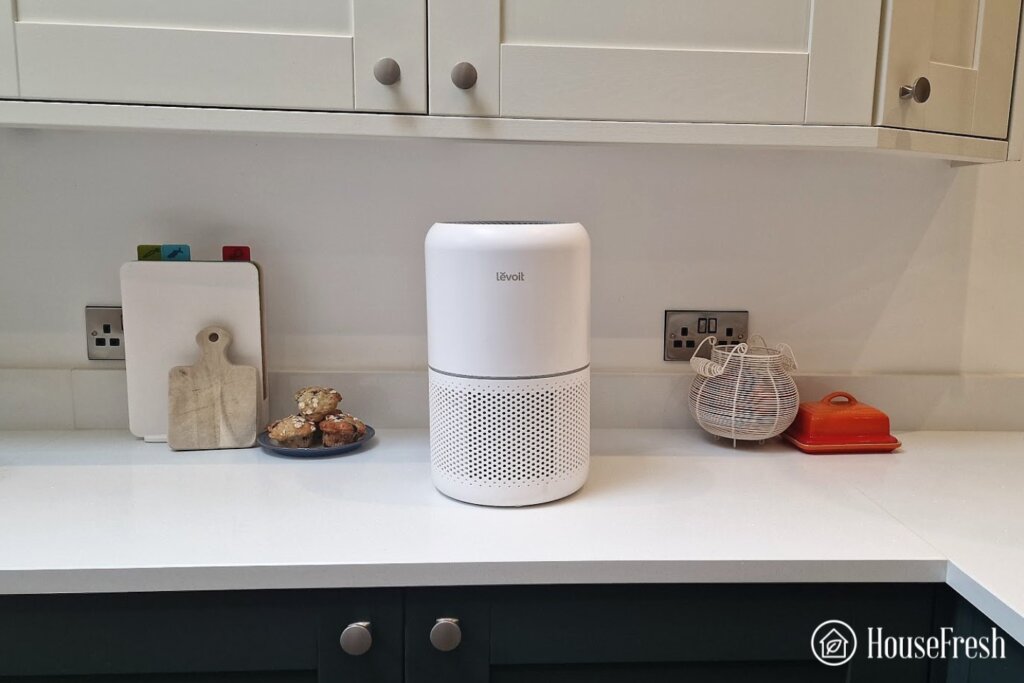
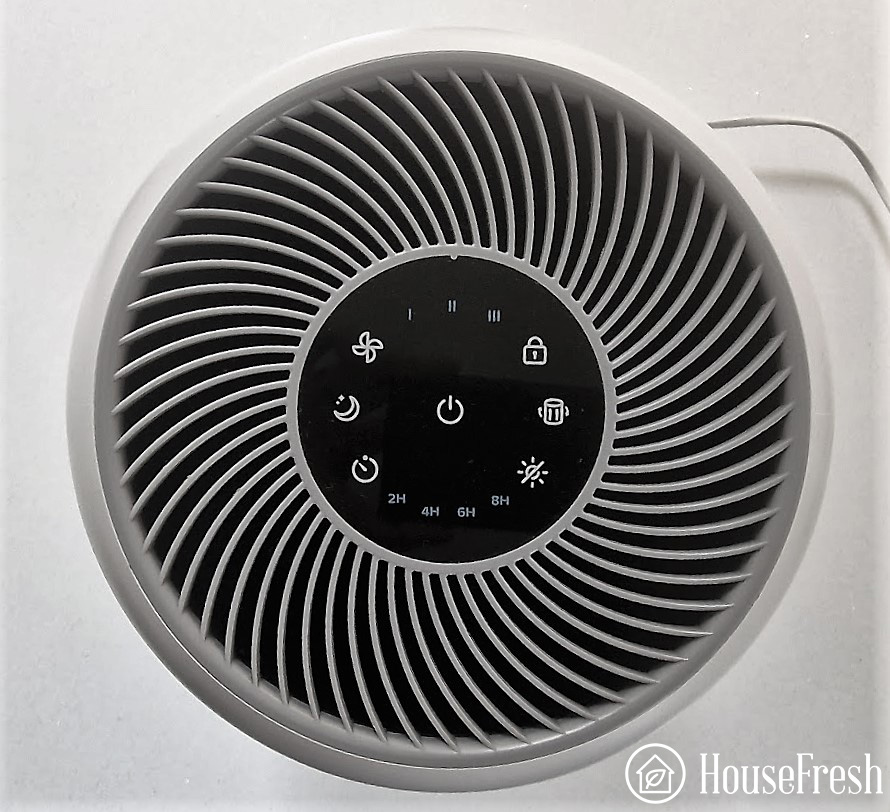
SPECS & FEATURES
| HouseFresh Rating: | ★★★★☆ |
| Time to clean our 728 cubic feet test room (with the device running at top speed): | 40 minutes |
| Air purifier technology: | Pre-filter, non-HEPA grade particle filter, and activated carbon pellets |
| Recommended room size (4.8 air changes per hour): | 219 sq. ft. |
| Clean air delivery rate (CADR): | Dust: 131 cfm Smoke: 126 cfm Pollen: 154 cfm |
| Dimensions (in inches / in cm): | 8.7L x 8.7W x 14.2H inches (22L x 22W x 36H cm) |
| Weight (in pounds / in kg): | 7.5 lbs (3.4 kg) |
| Filter life: | 6 – 8 months |
| Noise level in decibels (measured from 3 ft. away with a sound level meter): | Speed 1: 37.1 dB Speed 2: 48.5 dB Speed 3: 50.2 dB Top speed: 54.5 dB |
| Electricity consumption in watts (recorded with an electricity usage monitor): | Standby mode: 0.1 watts Sleep mode: 17.3 watts Speed 1: 19.7 watts Speed 2: 24 watts Top speed: 35.5 watts |
| Manufacturer’s warranty: | 2 years |
| Estimated energy consumption: | $47.30 |
| Country of manufacture: | China |
3. Best for medium-sized rooms: TaoTronics TT-AP003 ($99.99 + $65 per year)
The performance of the TaoTronic AP003 is better than the 33 minutes we saw with the Levoit Core 400S, which is $219.

The TaoTronics TT-AP003 is a game changer in budget air purifiers. Sold directly, it goes for $79.99 and has a CADR of 384 m³/h/226 CFM, similar to the Coway AP-1512 and Winix 5300, which cost nearly $200.
With a CADR cost of 35 cents per 1 CFM, this is the ultimate budget air purifier as of Spring 2023. When we tested this unit in our home lab, we found that it could remove all pollutants in 29 minutes, matching the manufacturer’s CADR results.
What we really like
What we think could be better
The cherry on top for the budget unit is that it also comes with an onboard sensor that gives the same pollutant levels for PM2.5 and PM10 — we usually see such extras on units that cost upwards of $300.
I’m not sure how Taotronics made such a great unit at such a low price, but as a consumer, I’m not complaining, and I’m sure the other air purifier manufacturers will need to up their game.
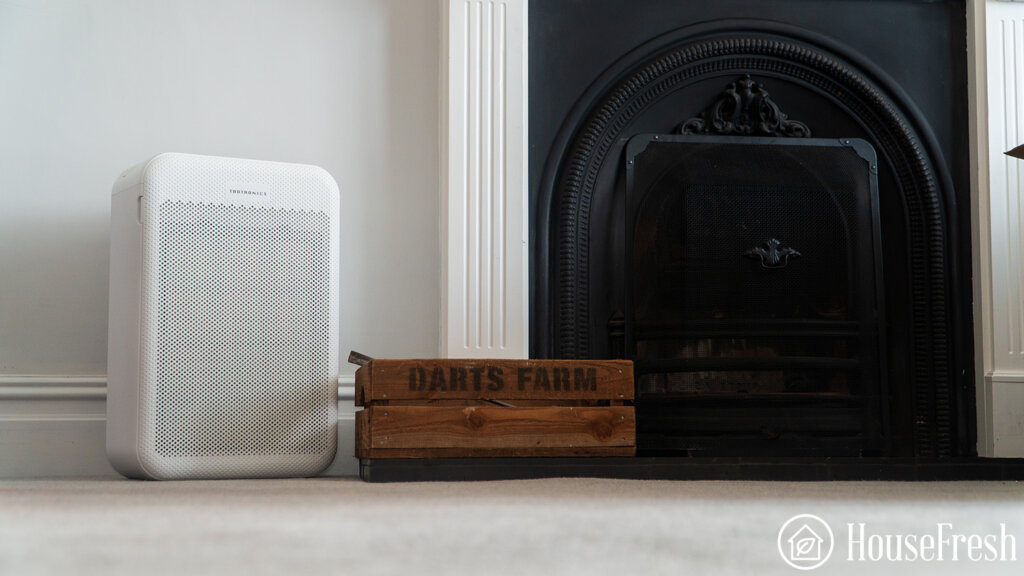

SPECS & FEATURES
| HouseFresh Rating: | ★★★★★ |
| Time to clean our test room: | 29 minutes |
| Air purifier technology: | H13 HEPA with activated carbon pellets |
| Recommended room size: | 322 sq ft (30 m²) |
| Clean air delivery rate (CADR): | 226 CFM (384 m³/h ) |
| Dimensions (in inches / in cm): | 21.8 x 14.1 x 7.9 inches (55.4 x 35.8 x 20cm) |
| Weight (in pounds / in kg): | 18 lbs (8.16 kg) |
| Noise level (measured from 3 ft. away): | Speed 1: 38.4 dB Speed 2: 42.8 dB Speed 3: 54 dB |
| Filter life: | 3 – 6 months |
| Electricity consumption (kilowatt-hour): | Standby mode: 0.7 kWh Speed 1: 5.9 kWh Speed 2: 10.5 kWh Speed 3: 36.5 kWh |
| Estimated running costs (electricity consumption + filter replacements): | $65.47 per year |
| Manufacturer’s warranty: | 1 year |
| Country of manufacture: | China |
4. Best DIY option: Corsi-Rosenthal Box ($80 upfront + $95 per year)
For around $80, you can buy everything you need to build your own air purifier — the Corsi-Rosenthal Box performs as well as many of the highest-rated units we’ve tested.

If you have a box fan and some extra HVAC filters, you might be able to get an air purifier running in your home without spending a thing. The Corsi-Rosenthal box requires you to build your device with the help of duct tape and cardboard.
When we got to test this air purifier in the same test we use for all purchasable air purifiers, it cleaned our test room in 25 minutes of particles sized 1 micron or less. This was the same level of particle removal speed as the $900 IQAir Healthpro Plus, so it’s not too shabby for something you can build yourself from easy-to-find parts.
What we really like
What we think could be better
For those needing an air purifier as quickly as possible, the Corsi-Rosenthal Box is the best solution out there, and that’s why it is our top recommendation for the best air purifier for wildfire smoke.
SPECS & FEATURES
| HouseFresh Rating: | ★★★★★ |
| Time to clean our test room: | 25 minutes |
| Air purifier technology: | HEPA Merv 13 |
| Recommended room size: | 680 sq. ft. |
| Clean air delivery rate (CADR): | Estimated: 247 CFM (419 m/hr) |
| Dimensions (in inches / in cm): | 20L x 20W x 20H inches (50L x 50W x 50H cm) |
| Weight (in pounds / in kg): | 10 lbs (4.5 kg) |
| Noise level (measured from 3 ft. away): | Speed 1: 49 dB Speed 2: 55.1 dB Speed 3: 60.7 dB |
| Filter life: | 6-12 months |
| Electricity consumption (kilowatt-hour): | Standby mode: 0 kWh Speed 1: 40.5 kWh Speed 2: 44.5 kWh Speed 3: 46.7 kWh |
| Estimated running costs (electricity consumption + filter replacements): | $106.46 per year |
| Manufacturer’s warranty: | n/a |
| Country of manufacture: | China |
5. TaoTronics TT-AP005 ($65.99 upfront + $67 per year)
An affordable, high-performing air purifier ideal for small to medium-sized rooms.

The TaoTronics TT-AP005, is the smaller brother of the AP003 and has a very similar size and shape to our number one budget air purifier, the Levoit Core 300. In our tests, it managed to clean our test room in 36 minutes, which is impressive considering it should cost $49.99.
What we really like
What we think could be better
Energy costs and filter replacements are some of the lowest on the market, but the major downside to this unit is its lack of availability on Amazon. Sadly, the company that makes them has been banned from Amazon, but there are a few third-party sellers out there, but they are often more expensive than buying direct.
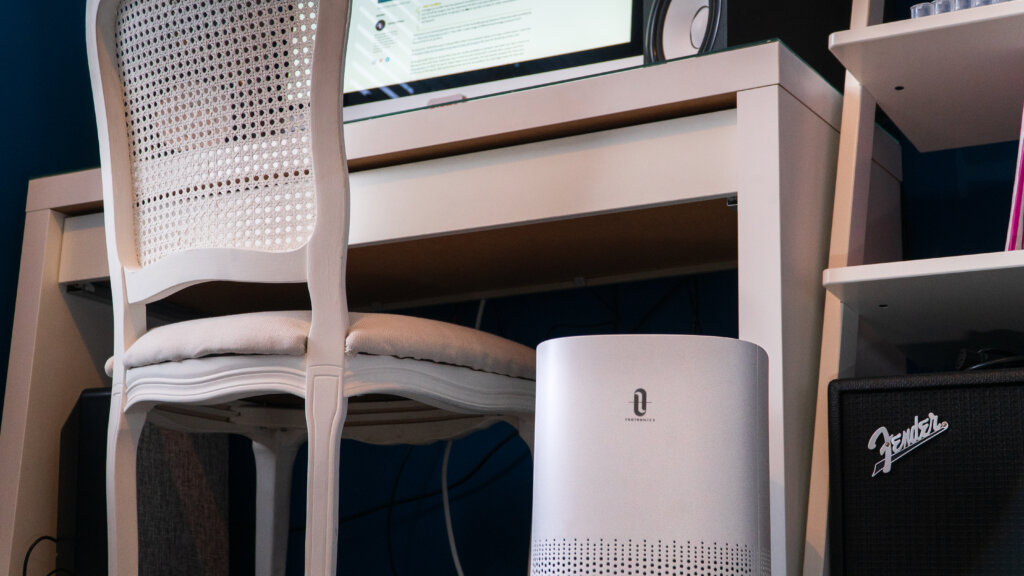
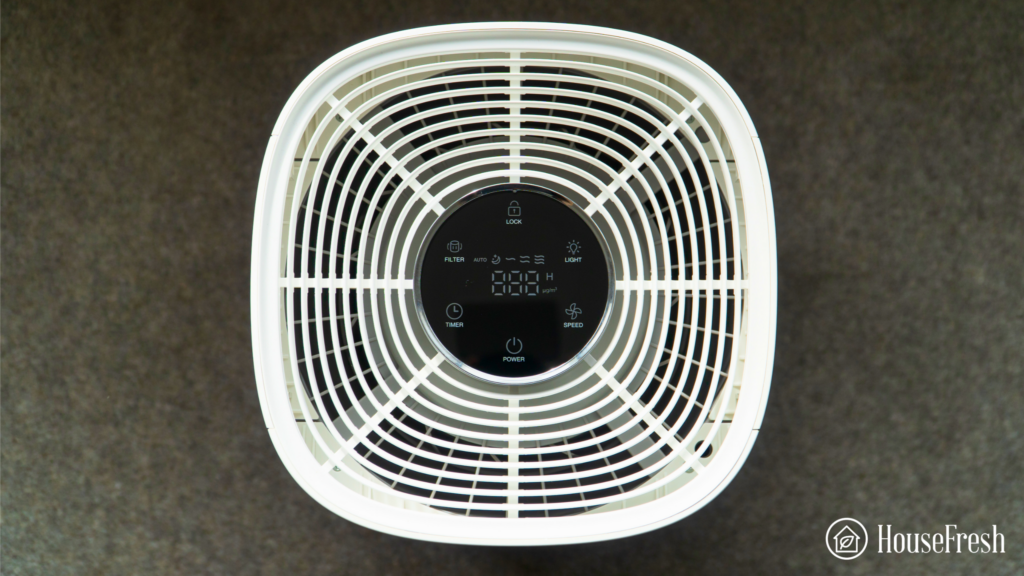
SPECS & FEATURES
| HouseFresh Rating: | ★★★★☆ |
| Time to clean our test room: | 36 minutes |
| Air purifier technology: | Pre-Filter, H13 True HEPA and Activated Carbon Filter |
| Recommended room size: | 270 sq. ft. |
| Clean air delivery rate (CADR): | 147 CFM (250 m³/h) |
| Price: | $65 |
| Dimensions (in inches / in cm): | 14.9H x 8.8W x 8.8D inches (37.8H x 22.4W x 22.4D cm) |
| Weight (in pounds / in kg): | 7.9 lbs (3.58 kg) |
| Noise level (low – high): | 25 – 50 dB |
| Filter life: | 3 – 6 months |
| Manufacturer’s warranty: | 1 year |
| Estimated energy consumption: | $30.48 per year |
| Country of manufacture: | China |
6. IKEA FÖRNUFTIG ($74.99 upfront + $74 per year)
I am glad to report air purifier from IKEA is the real deal — solid air cleaning performance in a good-looking package for an affordable price.

Many manufacturers in the air purifier space like to say how complex air cleaning is. However, this model from IKEA shows that it’s as simple as a good fan combined with a HEPA and activated carbon filter.
The HEPA filters can be found for $11.99, and the activated charcoal filters are $21.99. They are all available online, and in-store so that you can pick up some spare air filters the next time you visit for Swedish meatballs.
What we really like
What we think could be better
As you would expect with a gadget from IKEA, this air purifier has no bells or whistles. The device has one wheel to change speed and no air quality sensor. It doesn’t look like an air purifier, which might be a plus point for many — you could easily hide it in a living room without attracting too much attention.
It’s a great budget device, but the lack of features and overall costs means it doesn’t make our top spot.
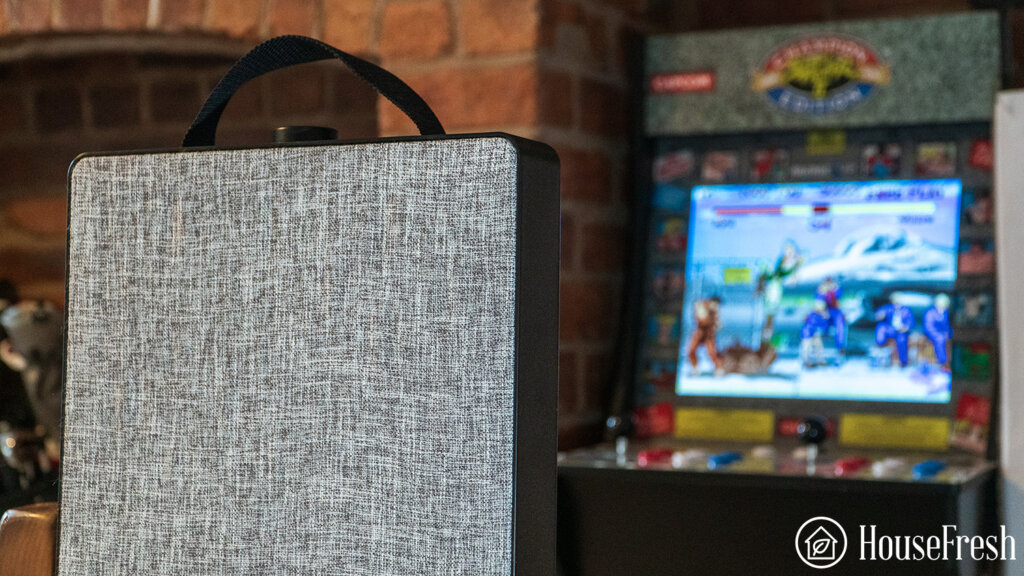

SPECS & FEATURES
| HouseFresh rating: | ★★★☆☆ |
|---|---|
| Time to clean our test room: | 61 minutes |
| Air purifier technology: | Pre-filter, HEPA 12 filter and Activated Carbon filter |
| Recommended room size: | 85 — 105 sq. ft. |
| Clean air delivery rate (CADR): | 70 CFM (119 m³/h) |
| Dimensions (in inches / in cm): | 18H x 12W x 4D inches (45.7H x 30.5W x 10.2D cm) |
| Weight (in pounds / in kg): | 6.7 lbs (3.04 kg) |
| Noise level (low – high): | 28 – 60dB |
| Filter life: | 6 months |
| Warranty | FÖRNUFTIG does not come with a warranty from IKEA |
| Estimated energy consumption: | $15.77 |
Other budget air purifiers that we tested but don’t recommend
We test many air purifiers here at HouseFresh and while we are continually looking for units like the Taotronics AP-003 that move the performance needle forward, we also come across a lot of duds. This is especially true at the sub $100 level, and so we felt it our duty to also point out those air purifiers you should avoid in this budget range.
- AROEVE MK01 – I could not find a published CADR for this unit, which would make sense as when we tested it, we found it took 163 minutes to clean our room to the levels recommended by the WHO guidelines. Remember that our test room (728 cubic feet) is the smallest in our house, so we can assume that this unit will be underpowered for most home use cases and should be avoided. The budget doesn’t have to be the thing that holds you back from having clean air in your home. Pay $20 extra and get the TaoTronics.
- Levoit Core Mini – The Core Mini is the smallest air purifier in the Levoit Core line. It comes with the same three-stage filtration (pre-filter, main filter and activated carbon filter) and it doubles down as a diffuser for essential oils. It only pulls 6.4 watts and generates just 44 dB of sound at its highest fan speed, but it took one hour and 53 minutes to remove all the pollutants in our relatively small test room. This budget unit is too underpowered for most rooms, but if you are looking for a way to clean the air in your RV or campervan, then this could be the one.
- GermGuardian AC482e – This air purifier seems awesome on the surface, especially as you will find glowing reviews from well-respected media organizations if you decide to Google it. There is only one problem — it’s not good at all. It might have been an OK choice a few years back, but the AC4825e failed to perform well in our home lab tests with a poor performance of 104 minutes. When the Levoit Core 300 can achieve this in 40 minutes, you must wonder what you are paying for with the GermGuardian AC4825e.
- Levoit Core 200S – The Core 200S is not bad, it is just not good enough for you to spend $89.99 on it. it comes with app support, emitts a maximum of 48dB of sound when running at its top speed and doesn’t pull too much power (28.82 watts max) but it took a full hour to clean the air in our test room. You could get a TaoTronics AP003 or a Winix A231 for that money and they would offer you much better air cleaning performance.
How to avoid wasting money when buying a budget air purifier
Air purifiers offer an excellent way to remove harmful particles and improve indoor air quality, but many high-end models come with a hefty price tag. You just need to know what to look for in a quality air purifier, and you’ll discover many high-performance units that are affordably priced. And we’re here to help!
Our guide for the best budget air purifiers outlines the critical things to consider when buying an air purifier.
1. HEPA + Activated carbon is a must
The filtration technology used in an air purifier is the most important thing to consider when buying an air purifier on a budget. I recommend you focus on finding a unit with a good particle filter, ideally HEPA-certified, and an activated carbon filter.
- HEPA filters are the “gold standard” in filtration technology. HEPA or high-efficiency particulate air filters are great at trapping microscopic allergens like dust, pollen, dander and mold spores. These filters capture large and small particles down to 0.3 microns that move through them.
- Activated carbon filters do a stellar job of removing these odors. Where HEPA captures large and small particles from the indoor air, the best budget-friendly air purifiers also include Activated Carbon filtration. The porous nature of activated carbon helps absorb odor and volatile organic compounds (VOCs) from the air. We recommend choosing a unit with pellets rather than impregnated fabric often found in cheap air purifiers.
2. Measure the room size and consider its CADR score
Room size is another critical factor when buying an air purifier. Air purifiers aren’t created equal. Larger units can effectively clean air in larger rooms, like classrooms, while smaller units might not.
Manufacturers usually provide the recommended room size for each unit, so this information shouldn’t be hard to find.
See the table below for the recommended room size and CADR rating.
| Room Size (sq. feet) | CADR (CFM) |
| 300 — 500 ft² | One air purifier with a CADR of at least 150 |
| 500 — 900 ft² | One or two air purifiers with a combined CADR of 300 — 500 |
| 1,000 ft² and over | One very large or 2-3 air purifiers with a combined CADR of 600 or higher |
CADR, or clean air delivery rate, measures the air volume an air purifier can clean in a given time. A higher CADR means the air purifier can effectively remove more pollutants from your room, so pick the unit with the highest CADR score.
Feel free to use our free tool that provides you with 4.8 air changes per hour, which is what the EPA recommends for portable air purifiers:
4. Smart features are not a must, so don’t overpay for them
Air purifiers with smart technology, like auto mode and app support, are easier and more convenient to operate.
However, units with such technology tend to be more expensive and might be above your price range if you’re working on a tight budget.
Focus more on performance rather than features. You can find units with similar performance as the smart models but at a lower price.
For example, the Levoit 300 performs as well as the smart Levoit Core 300S but is $50 cheaper.
5. Be wary of very cheap air purifiers
The device’s low price can often be a trap.
In our many years of experience testing air purifiers, we have yet to find an excellent unit for less than $50, yet Amazon has many units. In our experience, you need to spend at least $80 for something like the TaoTronics AP003 or $99 for the Levoit Core 300 to get a unit capable of cleaning your home air well./thing
Common questions about cheap air purifiers
As of when I’m writing this, the cheapest air purifier for getting the most cleaning power for $ spent is the TaoTronics AP-003 with 35 cents for a CADR of 1 CFM. You can use multiple products for larger spaces and still benefit from the cheap performance.
If you’ve researched the best air purifiers on the market, you may have noticed that most are in the $200 to $300 price range.
Budget-friendly air purifiers are challenging to find. Even the units advertised as “cheap air purifiers” range somewhere between $100 to $150. But that doesn’t mean you can enjoy clean, fresh air in your home without breaking the bank.
Plenty of bucket picks on the market are just as effective as the pricey models. The Taotronics AP-003 costs $79.99 directly but can be found for a little more with third-party sellers on Amazon.
HEPA alone won’t do anything about odors or VOCs. You must also use an activated charcoal or carbon filter to deal with smells and gasses. Activated charcoal has a proven record of removing odors and gases that get trapped inside.
If you have severe odors or issues with VOCs, you will want to look at air purifiers with a large amount of activated carbon. Be sure to look at our list of the best air purifiers for VOCs which has a few examples of these types of air purifiers.
On a basic level, to make an air purifier, you will need to attach a HEPA filter to a fan. The challenge is that the fan needs to be kept safe, so you are better off looking at resources like this guide on how to build a Corsi-Rosenthal Box from UC Davis.
Instructions in this helpful guide on the Smart Air blog can also be provided.
DIY projects are great when you have to use something today, but if you plan to use it regularly, you will find it better to invest in a cheap air purifier as it will last much longer and require less maintenance.
Small air purifiers can be the right choice when you are in a minimal space like a car and traveling by plane.
Still, for the home, I recommend choosing a unit at least as large as the Levoit Core 300, as otherwise, you will spend a lot on filters and will find it hard to have enough performance for even the smallest rooms.
Opening a door or a window is a significant first step to cleaning the air in your home. The challenge is when the air outside is worse; this is when a cheap air purifier can provide a way to clean the air without letting any more pollutants inside.
Wrapping up
Being on a small budget doesn’t mean you have to compromise on quality. Ensure your new unit has HEPA and Activated Carbon filters, and go for as high a CADR as your budget allows.
Smart features are nice but not essential for the budget buyer. Any units on this list give you quality at a great price, so you won’t go far wrong. Remember, we have tested every unit ourselves, so we know what we’re talking about.
Unlike other publications, we are not affiliated with any big media company or investment firm. We are an independent publisher, and we only focus on indoor air quality. We aim to help others improve the quality of the air they breathe in their homes, and we do this through easy-to-understand guides, original data reports and in-depth product reviews.
If you have any questions about our testing process or have a query we haven’t discussed, email me directly: danny@housefresh.com
Last update on 2024-04-17 / Affiliate links / Images from Amazon Product Advertising API




